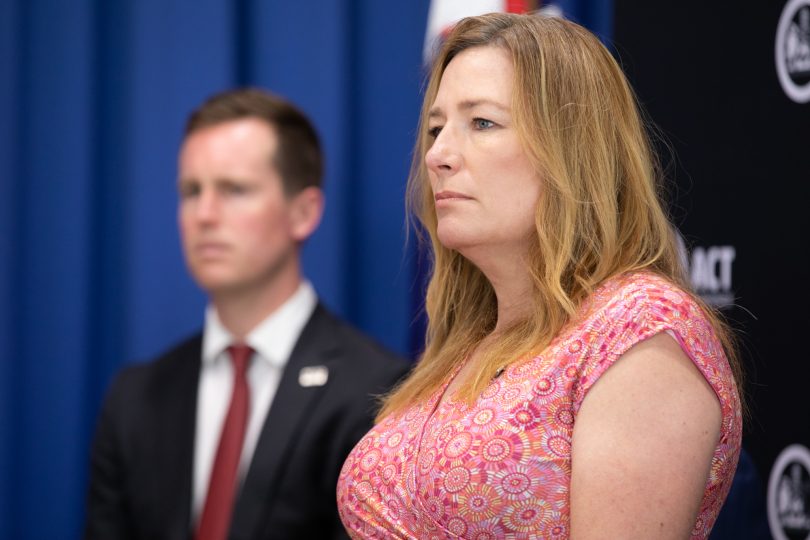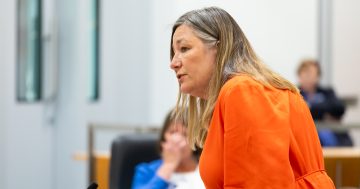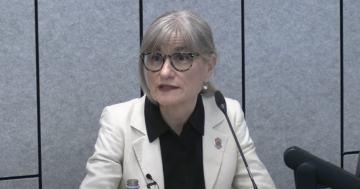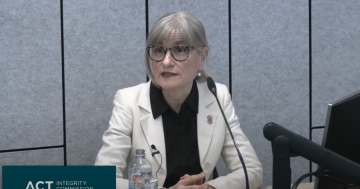
Education Minister Yvette Berry. Photo: Michelle Kroll.
The Education Directorate has defended its procedures and practices after a series of incidents exposed asbestos sheeting fragments and disturbed lead paint in ACT schools.
According to documents obtained by Region Media under Freedom of Information, it has been revealed that a staff member – because of “human error” – accidentally disturbed asbestos-containing material at Melba Copland Secondary School. All staff subsequently had to undergo refresher training in the aftermath of the incident.
A Ministerial Brief to Education Minister Yvette Berry dated 12 February 2020 identified a “management breakdown” in procedures at the school, and the prevalence of asbestos-awareness training and induction processes on-site were reviewed.
An Education Directorate spokesperson did not directly answer questions about whether training processes were insufficient at the time.
Less than six months later, on 30 June, a fragment of bonded asbestos sheeting was found in the soil of a restricted access area of Melba Copland Secondary School.
The area was tested and 5 cm of topsoil was removed from a two-metre radius by 5 July. A clearance certificate was issued the next day; however, a notice to the school community was still being prepared two weeks after the asbestos sheeting fragment was originally found, the briefing revealed.
On 2 July 2020 at Forrest Primary School, children were digging holes up to 30 cm deep in the playground when they discovered building debris, including a 10 cm fragment of bonded asbestos sheeting.
One child was reported to have been hitting the fragments with a shovel.
An exclusion zone was created and testing of the material was carried out four days later. Remediation works by licensed removalists were undertaken 10 days later. A subsequent scan of the grounds found no more surface debris.
These incidents occurred less than two years after the final report of an audit into asbestos management in ACT public schools was distributed.
“Forrest Primary School was built in the 1950s when asbestos was a commonly used building product,” an Education Directorate spokesperson said.
“The fragment of bonded asbestos was most likely buried underground as part of building debris when the school was constructed [which] was a relatively common building practice at the time.
“The licenced asbestos assessor advised that there was negligible risk of exposure from this find.”
Regarding Melba, the spokesperson said, “the source of that asbestos is historic, and cannot be tied to any recent activity”.
Further briefs provided to Ms Berry also included advice from Robson Environmental that a contractor hired by the school in the Gambarri Centre contributed to the elevated levels of lead dust found at the Yarralumla Primary School in July last year.
Lead-containing dust found at Yarralumla Primary School resulted from the removal of the windows, changes to the airflow due to the removal of the windows and painting work being done by another contractor at the same time, the spokesperson said.
When asked if the ACT Government has delegated the responsibility to manage hazardous materials in schools, the spokesperson said that schools have a maintenance budget and that contractors must check hazardous material plans before undertaking work in schools.
New processes were then flagged to ensure that future works, including painting, scheduled to be carried out in Education Directorate buildings that contain hazardous materials, would be solely managed by Infrastructure and Capital Works rather than the schools themselves.
The additional processes enacted the following month were to ensure that schools with hazardous materials must check with the directorate’s infrastructure team to make sure works are conducted in accordance with hazardous materials protocols.
Following media coverage of lead dust being found at Yarralumla Primary School in July last year, a concerned parent wrote to the Minister in early August requesting information on lead levels at the Curtin Primary School.
Six areas that needed remediation were subsequently found a month later when an assessment was carried out.
The directorate said work was already scheduled for Curtin Primary School and that the parent’s concerns expedited the process.
“Feedback from school communities on the condition of our schools is valuable and does assist us in prioritising our maintenance inspections,” the spokesperson said.
“In this case, feedback from the school community led to fast-tracking the already planned work.”




















